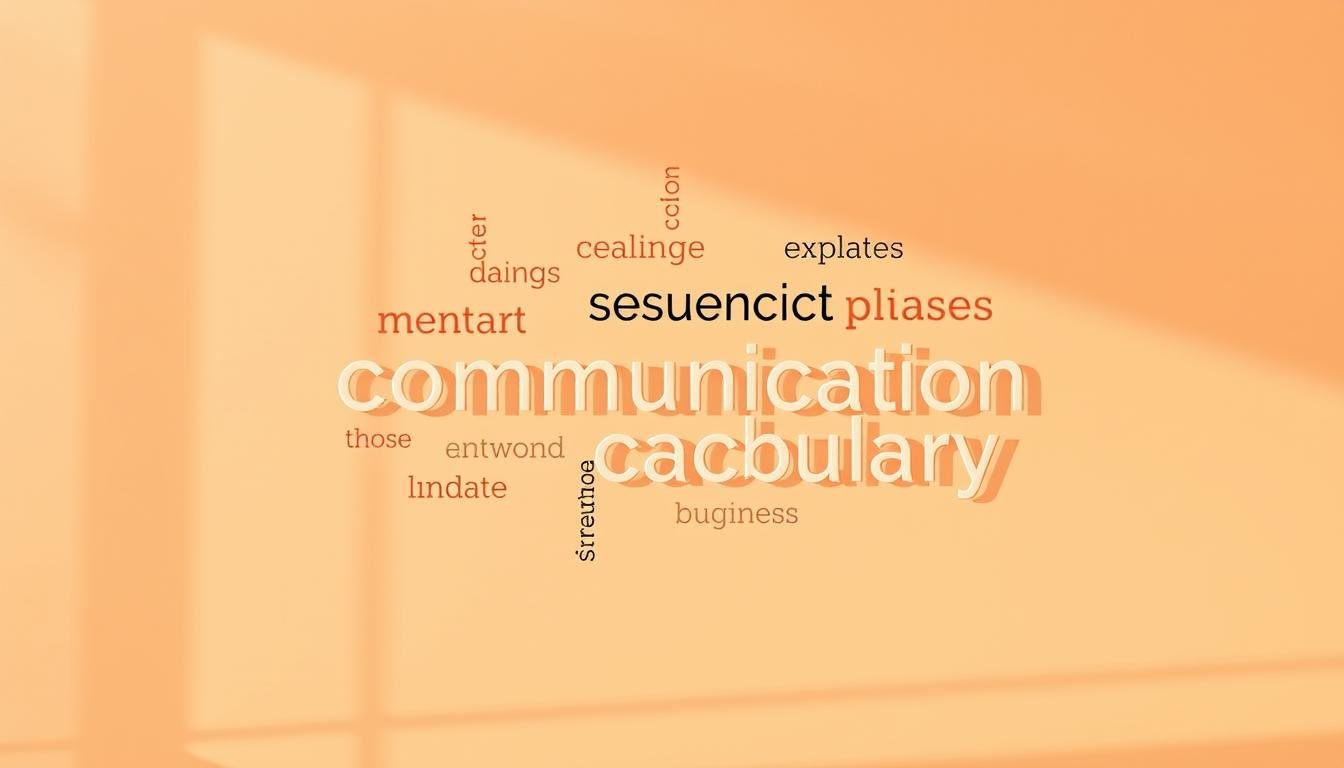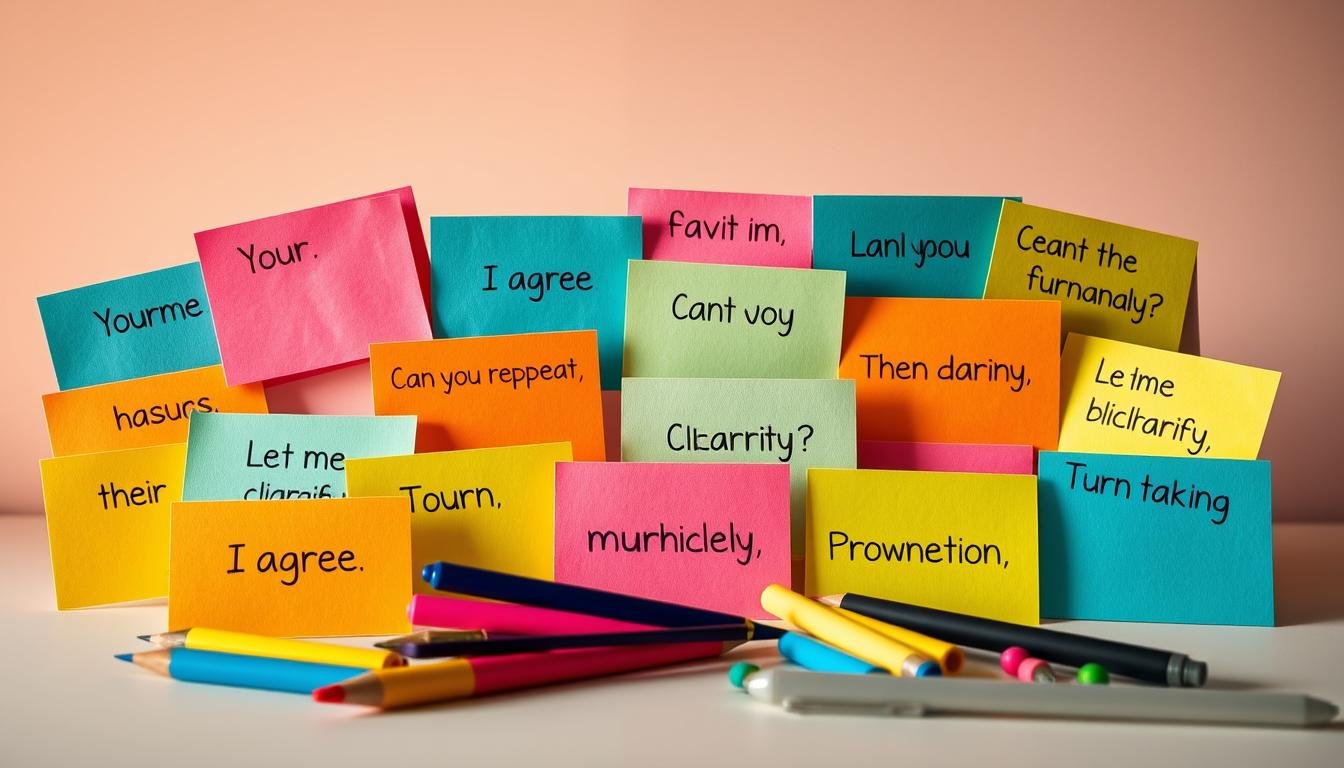Now Reading: Essential Vocabulary for Mastering Active Listening
-
01
Essential Vocabulary for Mastering Active Listening
Essential Vocabulary for Mastering Active Listening

Essential Vocabulary for Mastering Active Listening
Effective communication is key in any successful relationship. It’s about active listening, which means really focusing on what’s being said. Having the right communication skills words is essential for this.
When you know the right words, you can join in conversations better. You can also respond in a thoughtful way. This helps build deeper understanding and stronger bonds with others.

Key Takeaways
- Mastering vocabulary enhances active listening skills.
- Effective communication vocabulary is crucial for understanding.
- Using the right communication skills words improves responses.
- Active listening involves fully concentrating on the message.
- Possessing the right vocabulary fosters deeper connections.
The Fundamental Role of Active Listening in Effective Communication
Active listening is crucial in communication. It makes a big difference between just hearing and really understanding. Good communication is about sending and getting messages right.
Defining Active Listening in Today’s Communication Landscape
Active listening is more than just hearing words. It’s about catching the feelings, needs, and worries behind them. Active listening techniques include eye contact, nods, and words that show you get it.
The Psychological Impact of Being Truly Heard
Feeling heard deeply affects our minds. It makes us feel understood and valued. This can make relationships stronger and build trust. The listening skills vocabulary used shows empathy and attention.
Distinguishing Between Hearing and Listening
Hearing is passive, but listening is active. The main differences are:
- Intent: Listening means you really want to understand.
- Attention: Listeners stay focused, ignoring distractions.
- Response: Active listeners show they get it with the right response.
Knowing the difference helps improve communication. It leads to more meaningful talks.
Core Vocabulary for Active Listening: An Overview
To truly listen, you need to know the key words for active listening. This knowledge helps you talk better and connect deeper with others.
The Linguistic Components of Effective Listening
Good listening involves many words and phrases. Verbs like “to participate” and “to respond” are key for good conversations. Nouns like “listener” and “intention” show the listener’s role and focus.
How Vocabulary Shapes Listening Behavior
The words you use change how you listen. Using dialogue-enhancing words makes listening more empathetic. This leads to better understanding and honest talks.
Building Your Active Listening Lexicon
Building a strong listening vocabulary means learning new words. It’s about using language for empathetic listening, like saying “I understand” or asking for clarity. This makes you a better listener.
Learning the core vocabulary for active listening is key to better communication. It helps you have more meaningful and productive talks.
Key Verbs That Enhance Active Listening Skills
Active listening gets better with the right verbs. These verbs help us listen better by making us more involved and understanding. Using these verbs in our talks can really boost our listening skills.
To Participate: Techniques for Engaging in Dialogue
Being part of a conversation is key to active listening. Verbs like “to participate” make us more involved. Using conversation starters is a great way to get others to share their thoughts and feelings.
Open-ended questions can lead to deeper talks. They help us understand more about what the other person is saying. This shows we care and helps us connect better.
To Respond: Crafting Thoughtful and Supportive Feedback
Responding well is also important in active listening. The verb “to respond” helps make our talks supportive and engaging. Giving thoughtful feedback means we listen and then share our thoughts carefully.
Using phrases like “That makes sense because…” shows we get what they’re saying. It makes them feel heard and encourages them to keep talking.
Additional Verbs: Acknowledge, Clarify, Reflect, and Validate
Other verbs are also key for better listening. Verbs like “acknowledge,” “clarify,” “reflect,” and “validate” help make sure we understand each other well.
- Acknowledge: It’s about recognizing what the speaker says, showing we’re paying attention.
- Clarify: It’s about asking for more info to make sure we get it right.
- Reflect: It’s about mirroring what they say or feel, showing we understand.
- Validate: It’s about saying we see their feelings or experiences, making them feel heard.
Using these verbs in our active listening phrases can make our communication skills words better. This leads to more effective and caring conversations.
Essential Nouns in the Active Listening Process
Knowing the key nouns is crucial for active listening. These nouns are the base for good listening. They help people fully connect with others in talks.
The Listener: Roles, Responsibilities, and Mindset
The term “listener” means more than just the person hearing. It includes their role, duties, and mindset. A good listener knows their own biases and tries to ignore them to really hear the speaker.
The listener’s mindset is key. It shapes how they understand the message.

Intention: Purposeful Attention in Communication
Intention is vital in active listening. It’s about focusing on the speaker with purpose. When a listener aims to listen well, they catch the subtleties of what’s being said.
Other Critical Nouns: Empathy, Perspective, Context, and Presence
Other important nouns in active listening are empathy, perspective, context, and presence. Empathy lets the listener feel what the speaker feels. Perspective helps see things from the speaker’s angle. Knowing the context of the message is key for correct understanding. Being fully present makes the conversation better.
By focusing on these nouns, people can improve their listening skills vocabulary. This leads to better verbal communication terms and more effective communication vocabulary.
Adverbs and Descriptors That Transform Listening Quality
Adverbs and descriptors are key in making listening better. They help us listen with empathy and engagement. It’s not just about hearing words, but also understanding and responding to them.
Good listening is more than just hearing. It’s about being active and involved. Adverbs like “actively” highlight the importance of being fully engaged.
Actively: Moving Beyond Passive Reception
Listening actively means being fully present and engaged. It’s about understanding more than just the words. It’s about catching nuances and showing you care.
To listen actively, stay focused and avoid distractions. Use nods and summaries to show you’re following the conversation.
Nodding and Other Non-Verbal Affirmation Techniques
Nodding is a powerful tool in active listening. It shows you’re engaged and following the conversation. Other cues include eye contact and open body language.
- Nodding to show agreement or understanding
- Maintaining eye contact to show engagement
- Using open and attentive body language
These cues make the speaker feel heard and understood. They greatly improve listening quality.
Attentively, Empathetically, Patiently: The Adverbs of Superior Listening
Adverbs like attentively, empathetically, and patiently describe superior listening. They show what makes a listener truly great.
Listening attentively means focusing on the message’s details. Listening empathetically means understanding the speaker’s feelings. Being patient lets you fully absorb the information.
“The art of listening is being able to repeat what someone else has said, without being interrupted, and without your response being prepared in your head while they’re still speaking.”
Using these adverbs in our listening can greatly improve our connections with others. It helps us build stronger, more meaningful relationships.
Practical Phrases and Expressions in Active Listening Vocabulary
## Practical Phrases and Expressions in Active Listening Vocabulary
Active listening is key to good communication. Using the right phrases can make you a better listener. We’ll look at some useful phrases for active listening.
### Clarification Techniques: “If I understand correctly…”
Clarification is important in active listening. It makes sure you get the speaker’s message right. Phrases like “If I understand correctly,” “Just to clarify,” and “Can you explain that again?” help clarify things.
### Validation Statements: “That makes sense because…”
Validation shows you’re really listening. Phrases like “That makes sense because,” “I understand what you’re saying,” and “That clarifies things” show you’re engaged.
### Thoughtful Follow-up Questions and Prompts
Good follow-up questions help the speaker share more. Open-ended questions like “Can you tell me more about that?” and “How did you come to that conclusion?” prompt for more details.
#### Open-Ended Question Formulations
Open-ended questions get detailed answers. Questions like “What do you think about…”, “How do you feel about…”, and “Can you share your thoughts on…” encourage deeper thoughts.
#### Probing for Deeper Understanding
Probing questions seek more insight. Questions like “What do you mean by…”, “Can you elaborate on that?”, and “How does that relate to…” help understand more.
Using these phrases can improve your listening skills. It makes conversations more engaging and effective.
By actively using these phrases, you can make conversations more interactive. It shows you’re really listening.
Self-Assessment: Recognizing Active Listening Behaviors
To improve your listening skills, it’s key to know your own listening habits. Thinking about how you listen can show you how others see your listening ability.
Reflection Question: “Have Others Thought You Weren’t Listening?”
Think about times when people thought you weren’t paying attention. What made them think that, and how did you react?
Identifying Your Personal Listening Habits and Patterns
Knowing your listening habits is important for good communication. Being aware of how you listen helps you talk better with others.
Vocabulary for Describing Listening Behaviors and Actions
Learning words to talk about your listening can make your listening stories clearer. This helps you talk better and understand listening better.

By looking at yourself and thinking deeply, you can get better at listening. This makes you talk better and meet others’ needs more thoughtfully.
Overcoming Barriers with Specialized Vocabulary for Active Listening
Learning the right words for active listening is crucial. It helps us talk better. Using the right words makes listening more effective.
Terms for Identifying Common Listening Obstacles
First, we need to know what gets in the way of listening. Words like “distraction,” “preconception,” and “bias” help us spot these issues. Once we know, we can start to fix them.
- Distraction: Things that take our attention away.
- Preconception: Ideas we already have that shape what we hear.
- Bias: Biases that change how we take in information.
Vocabulary for Addressing Distractions and Biases
To deal with distractions and biases, we need the right words. Saying “Let’s focus on,” “To clarify,” and “I understand that” helps keep conversations on track. It also shows we’re aware of biases.
Language Tools for Maintaining Focus and Presence
Staying focused and present is key for good listening. Using mindfulness terms and phrases helps a lot.
Mindfulness Terminology in Listening
Words like “mindful listening” and “present in the moment” help us listen better. They teach us to stay focused and not judge.
Recovery Phrases When Attention Lapses
When we lose focus, saying “As you were saying,” “Could you elaborate on,” and “I’m sorry, could you repeat that” helps. It keeps the conversation flowing.
Using these special words in our daily talks can really boost our listening skills. This leads to better and more caring conversations.
Conclusion: Mastering the Language of Active Listening
Learning to listen actively is key for good communication. By using the right effective communication vocabulary, people can get better at listening. This article has shown the important words and methods for active listening.
Practicing the vocabulary and phrases talked about here is crucial. It helps people have better conversations, form stronger bonds, and handle tough talks more smoothly.
As people get better at listening, they’ll use communication skills words that help them understand and connect with others better. Using these skills every day leads to more effective and peaceful communication.
FAQ
What are some essential verbs for active listening?
Key verbs for active listening include “to participate,” “to respond,” and “to acknowledge.” Also, “to clarify,” “to reflect,” and “to validate” are important. They help in engaging and understanding conversations.
How can vocabulary impact active listening skills?
The right words can greatly improve your listening skills. They help you grasp and reply to messages better.
What is the difference between hearing and listening?
Hearing is just about sensing sound. Listening, however, means understanding the meaning behind the sounds. It’s a more complex and engaging activity.
What are some common obstacles to active listening?
Distractions, biases, and lack of focus often hinder active listening. Using special words and techniques like mindfulness can help overcome these challenges.
How can adverbs and descriptors improve listening quality?
Words like “actively,” “attentively,” and “empathetically” describe better listening. Non-verbal signs like nodding also show you understand.
What are some practical phrases for active listening?
Useful phrases include “If I understand correctly…” for clarity and “That makes sense because…” for validation. Open-ended questions also promote meaningful talks.
How can one assess their own active listening behaviors?
Reflect on your listening habits to see where you can improve. Use vocabulary to describe your listening actions. This helps you become more aware and effective.






























